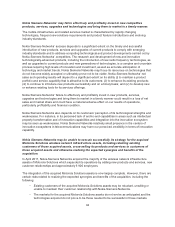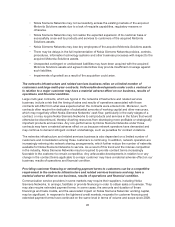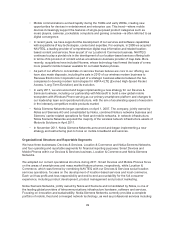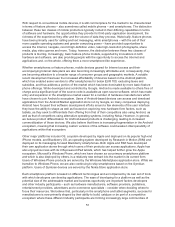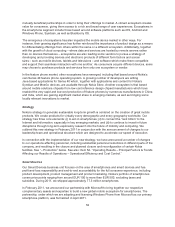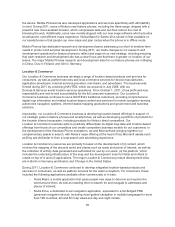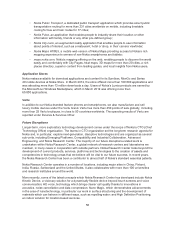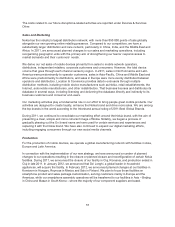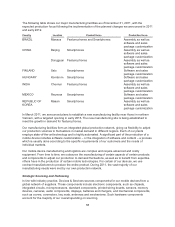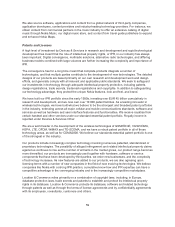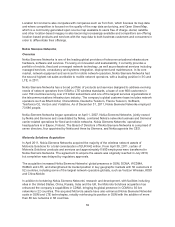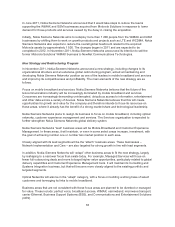Nokia 2011 Annual Report Download - page 55
Download and view the complete annual report
Please find page 55 of the 2011 Nokia annual report below. You can navigate through the pages in the report by either clicking on the pages listed below, or by using the keyword search tool below to find specific information within the annual report.While Microsoft is continuing to license Windows Phone to other mobile manufacturers, the Microsoft
partnership is providing us with opportunities to innovate and customize on the Windows Phone
platform, such as in imaging and location-based services where we are a market leader, with a view to
differentiating Nokia smartphones from those of our competitors which also use the Windows Phone
platform. We are contributing our expertise on hardware, design and language support, and plan to
bring Windows Phone to a broad range of price points, market segments and geographies. We and
Microsoft are closely collaborating on joint marketing initiatives and a shared development roadmap to
align on the future evolution of mobile products. The goal for both partners is that by bringing together
our complementary assets in search, maps, location-based services, e-commerce, social networking,
entertainment, unified communications and advertising, we can jointly create an entirely new consumer
proposition. We are also bringing together our developer ecosystem activities to accelerate developer
support for the Windows Phone platform on Nokia devices.
In October 2011, we launched the Nokia Lumia 800 and Nokia Lumia 710, our first products based on
the Windows Phone platform. Our Lumia range is designed to bring consumers attractive industrial
design in different colors, a fast social and Internet experience, leading imaging capabilities and
signature Nokia experiences optimized for Windows Phone, such as Nokia Drive, our turn-by-turn
voice-guided drive navigation application. The Nokia Lumia 800, which features a 3.7 inch AMOLED
ClearBlack curved display, went on sale to consumers in six major European markets during
November 2011, with a retail price of approximately EUR 420, excluding taxes and subsidies. Towards
the end of 2011, we also started selling both the Nokia Lumia 800 and Nokia Lumia 710 in Hong Kong,
India, Russia, Singapore and Taiwan. The Nokia Lumia 710, which features a different design, retails
for approximately EUR 270, excluding taxes and subsidies.
Since the start of 2012, we have continued to bring the Lumia experience to several more geographies.
For example, we launched the Nokia Lumia 900 in the United States, our third Windows Phone product
and first LTE device designed specifically for the North American market, available exclusively through
AT&T. In late February 2012, we announced our intention to bring the Lumia 900 to other markets
outside the United States and introduced the Lumia 610, our lowest cost Lumia smartphone to date.
These initial Lumia products represent the first significant step in our efforts to regain smartphone
leadership.
While we transition to Windows Phone, we expect to continue to ship Symbian devices in specific
regions and distribution channels, as well as to continue to provide software support to our Symbian
customers, through 2016. During 2011, we made significant changes to our research and development
operations for smartphones to reflect our new strategy. These changes included personnel reductions
as well as the transfer of approximately 2 300 employees to Accenture as part of an agreement in
which Accenture is providing Symbian software development and support activities to Nokia through
2016. We brought seven Symbian devices to market during 2011, three of which are powered by Belle,
the latest version of the Symbian software. Belle brings a major improvement to the user experience,
including single-tap NFC (near field communication) technology sharing and pairing and a more
powerful mobile web browsing experience. In late February 2012, we also announced the Belle-
powered Nokia 808 PureView, our most capable imaging device to date. The Nokia 808 PureView has
a four inch screen, HD video recording and playback, and Dolby Digital for 5.1 channel Dolby Digital
Surround Sound.
During 2011, we also launched the Nokia N9, the outcome of efforts in our MeeGo program. Made
available to consumers in the fourth quarter 2011, the Nokia N9 is a pure touch smartphone which
introduces an innovative new design where the home key – typically located at the bottom of the
device – is replaced by a simple swipe gesture. Under our new strategy, MeeGo has become an
open-source, mobile operating system project with an emphasis on longer-term market exploration of
next-generation devices, platforms and user experiences. We aim to bring a variety of innovations that
emerge from our MeeGo program as well as learnings from the Nokia N9 to future products.
53



